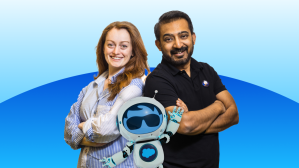In a panel hosted by the Washington Post, Peter Schwartz, chief futurist at Salesforce; Mona Vernon, chief technology officer, Thomson Reuters Labs; and Douglas Terrier, acting chief technologist at NASA offered their views on the evolution of AI and and its impact on the future of work. The panel was moderated by Anna Rothschild, science reporter at the Washington Post.
All of the panelists shared the belief that AI will augment humans, not replace or rule them. “There are a lot of bad people to deal with before we get to bad robots,” Schwartz said.
Robots are already working alongside humans in factories, and AI will continue to take on tasks that are better suited for intelligent machines. Thomson Reuters built a tool that deals with understanding increasingly complex data privacy regulation and proliferation of information. “This gives data privacy experts an augmentation, or superpower, so they don’t miss information they would otherwise be looking for,” Vernon said.”Under the umbrella of AI is the maturity of a set of digital technologies that now can really help emerging markets leapfrog.”
“In the search for earth-like planets we have use a lot of machine learning and AI to process the volumes data. No human can look at the volume of data and sort out the patterns in it. Those same algorithms are used in any big data set when we try to look for patterns, such as looking at crops around the country and how to reprogram airplane flight paths,” Terrier said.
According to Schwartz, a shortage of jobs won’t be the problem in the AI future, but many occupations will require retraining and new skills. He predicts that a “delivery economy” is emerging that will require more truck drivers, not less, as self-driving vehicles take over to streets. “The truck driver of tomorrow is actually going to behave like the guys who fly remote piloted vehicles today,” he said.
Like drone pilots, the new generation of truck drivers will be able to remotely operate several vehicles. “They’ll drive it around the city streets, supplementing the AI on board, and the AI will drive down the freeway. So, they’ll be driving five trucks, not one. And in fact, a company in Las Vegas called Starsky Robotics is actually building it right now; they think they can do 10 trucks,” Schwartz said. “The skillset is Grand Theft Auto,” he added.
“We’re going to have to update our skills as the technology continues to change, because it’s going to be a continuous process,” Terrier said. This will require investments from both the private and public sector.
While the panelists were optimistic about the AI-augmented future and economic opportunities, they express concern about the “black box” problem, determining how an algorithm arrived at a decision and whether it is working equitably and fairly. “This is an especially difficult issue because as the algorithm gets more and more sophisticated, it learns, becomes more complex, and it is frankly, very difficult to unpack why it made the particular recommendations,” Schwartz said. “And if it’s made a recommendation that you get credit for your house and you don’t, she wants to know why. And that is a challenge of unpacking that algorithm….I do think this is a bit of a challenge for the industry, to try and figure out the rules for algorithmic transparency.”
Watch the video or read the transcript of the full Washington Post Live Transformers: Artificial Intelligence event.




















